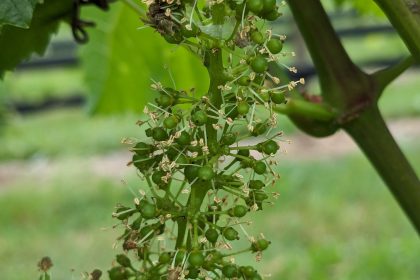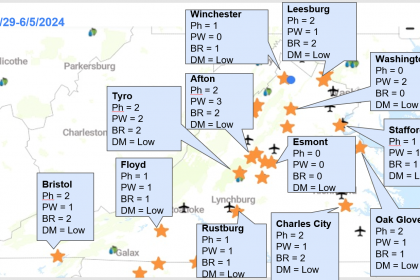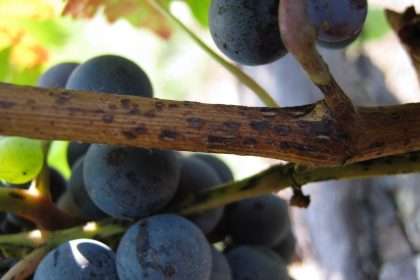Many people in northern VA are about to see blooms in a few weeks, and I am sure the rest of the regions are about to see bloom very soon. Bloom is a start of the critical time for cluster infections by downy mildew, powdery mildew, and black rot. Bloom time is also the critical period to prevent Botrytis, ripe rot, and bitter rot, because pathogens of these diseases can infect flower parts and develop symptoms later.
What I recommend often is the use of protectant materials to protect tissues for 4-6 weeks for V. vinifera varieties, and 3-4 weeks for V. labrusca varieties, which should translate into 3-4 sprays for V. vinifera, and 2-3 sprays for V. labrusca. If you have hybrids, they are somewhere in between, so, 4-5 weeks to be protected. As usual, please make sure to rotate mode of action (= FRAC) groups.
Since we have experienced rain every weekend (and looks like another rainy weekend coming up), we need to be on top of downy mildew and black rot management. In our vineyards, I noticed that there were several leaves with small lesions of downy mildew.
Protective materials for downy mildew are: Mancozeb (FRAC=M3) [Gavel has mancozeb + zoxamid (FRAC=22)], Captan (FRAC=M4), Fixed copper (FRAC=M1), Revus or Forum (FRAC=40), or Zampro (FRAC = 40+45), or Ranman (FRAC=21)). (Please note that there is an increasing case of Revus resistant downy mildew isolates in VA. Plus, resistance to Ranman is known among downy mildew pathogens of other crops. Make sure to spray before the rain and rotate!)
Protective materials for black rot are: Mancozeb, QoI (FRAC=11, Aboud, Flint, Pristine, Intuity, etc.), and DMI (FRAC=3, tebuconazole, Elite, Rally, etc). Captan and copper won’t work against black rot.
We do have materials with kick-back activities against downy (Ridomil products (FRAC=4), phosphite (FRAC=P07, Prophyt, Phostrol, etc.) and black rot (myclobutanil (FRAC=3, DMI), etc.),. However, they can be effective between infection and establishment of the pathogen (i.e., the day of rain and 3-4 days after). We do not have any eradicant that can kill already established pathogens. Infection on flowers and young fruits can happen very fast. Unless we have a very dry season (which is a rather rare event), this is the time where you have to be proactive. Thus, please protect your vines. Do not wait until you see diseases!
Also please note that recent warm and humid nighttime conditions are favoring spore production of downy mildew pathogen. For example, since 5/1, there were six days with RH near 90% and the temperature was in the 60’s. It is not as threating as in 2018, where at this time of the season, we already had several days of RH > 90% and temperature > 70F, but we still need to be on alert.
In addition to downy and black rot, we need to think of Botrytis, ripe rot, and powdery mildew. (I will cover Botrytis in more details in the next post (probably tomorrow), since this post is getting very long already.)
Here are three examples I thought of considering current conditions. (Note: I am considering a phosphite (e.g., Prophyt) and Ridomil products, but not listed in the plan. I will add a phosphite or Ridomil products for downy mildew whenever we have many rain events. Please limit the use of Ridomil products to twice a season for resistance management)
Plan A (my “standard” program)
- At bloom: mancozeb + sulfur (FRAC=M2) + myclobutanil or another DMI + Vangard (FRAC=9, or other Botrytis material)
- First cover: mancozeb + sulfur + Quintec (FRAC=13) (or other PM material, such as Vivando (FRAC=50) or Torino (FRAC=U6))
- Second cover: mancozeb + sulfur + myclobutanil or another DMI
- Third cover: captan (FRAC=M4) + sulfur + Quintec (or other PM material, such as Vivando or Torino) (Note: if I do not see any evidence of powdery mildew, I may omit Quintec from this spray)
Plan B (if your major concern is downy mildew: note: I will add a phosphite or Ridomil product based on rain condition)
- At bloom: mancozeb + sulfur + Revus Top (FRAC=40+3) + Vangard (or another Botrytis material) (note: Revus Top contains a DMI, which should provide extra kick against powdery mildew. Also, you can use Gavel for mancozeb to have additional downy mildew material.)
- First cover: mancozeb + sulfur + Quintec (or other PM material, such as Vivando or Torino) (I may add Ranman to add more protection against downy here)
- Second cover: mancozeb + sulfur + Revus Top
- Third cover: captan + sulfur + Quintec (or other PM material, such as Vivando or Torino) (Note: if I do not see any evidence of powdery mildew, I may omit Quintec from this spray)
Plan C (if your major concern is Botrytis and powdery mildew)
- At bloom: mancozeb + sulfur + Luna Experience (FRAC=7+3, Luna Experience contains a DMI) (Using FRAC=7 will give you an opportunity to use other Botrytis material (say, FRAC=9, 17, etc), if bloom last longer than expected or use these FRAC at the other spray timings (bunch closure and veraison))
- First cover: mancozeb + sulfur + Quintec (or other PM material, such as Vivando or Torino)
- Second cover: mancozeb + sulfur + myclobutanil or another DMI
- Third cover: captan + sulfur + Quintec (or other PM material, such as Vivando or Torino) (Note: if I do not see any evidence of powdery mildew, I may omit Quintec from this spray)
The spray interval depends on the weather conditions; so, I cannot give you a specific number. However, in general, I would aim for shorter intervals for the bloom, first, and second cover (7 to 12 days), but I may relax a bit for the third and subsequent sprays (10 to 14 days), especially if weather conditions do not favor disease development (i.e., dry).
Please note that I was saving my DMI and Quintec (or Vivando, or any other new powdery material) usages for the critical period, thus this is the only time I spray these materials. If you have already used these materials, please rotate with another FRAC group.
I would like to use a mancozeb product around bloom and critical because it has activities against multiple pathogens including pathogens for black rot and ripe rot. Captan and copper are not as effective as mancozeb when it comes to black rot management. The third cover may become too close to the 66-day PHI, so, you need to be careful with the usage of a mancozeb product.
Of course, the examples above are just examples, and there are many other options. For example, there are many materials available for both downy and powdery mildew management in recent years. Please refer to our PMG for more details. A link to 2019 PMG is located on the right-hand menu of this blog (or at the bottom, if you access here with your smartphone or tablet)





